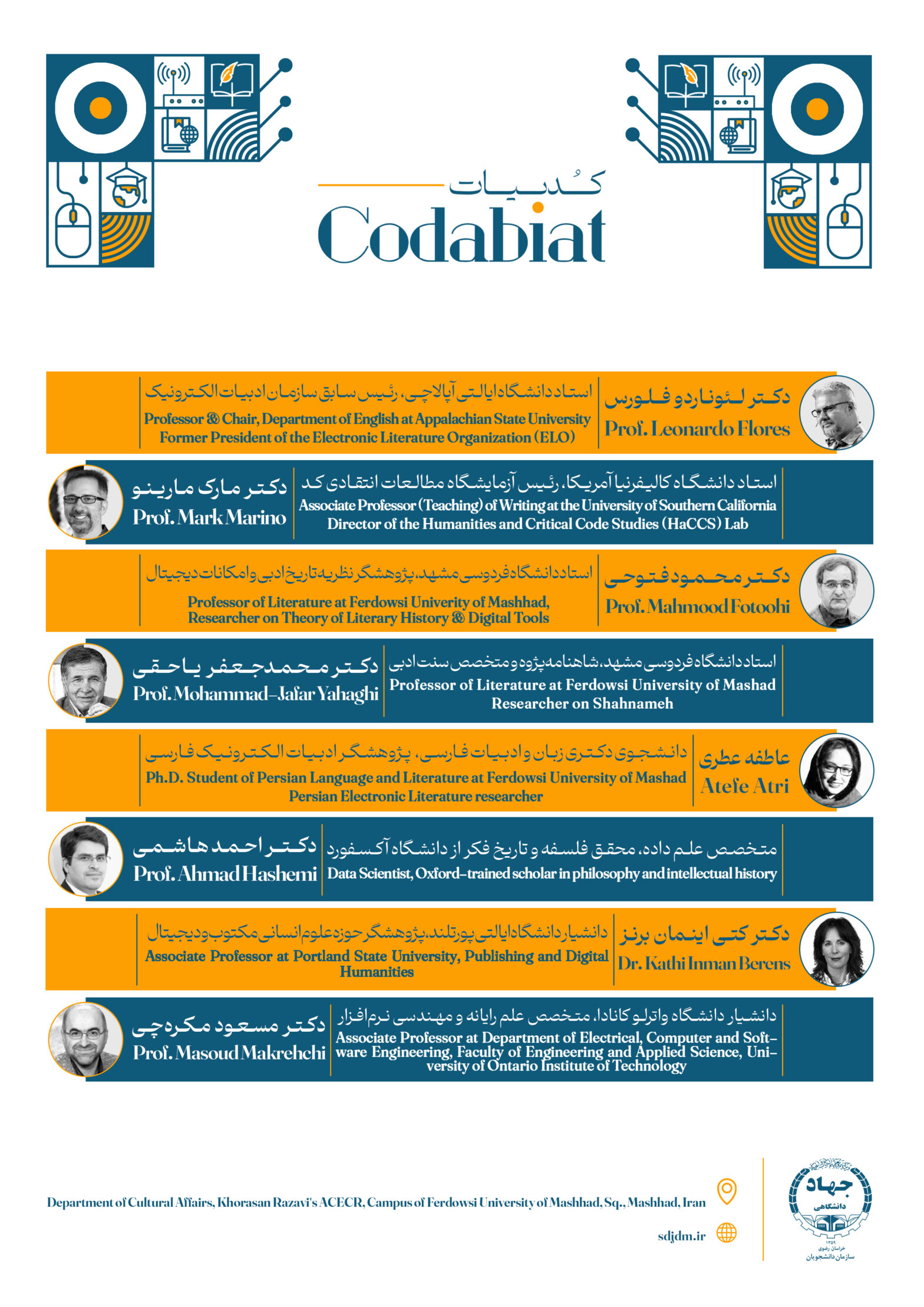I have created this presentation for an event titled CodAbiat on October 19, 2023 in Ferdowsi University of Mashhad in Iran, for which I am grateful to have been invited to share some of my work in the field. Inspired by the name of the event– CodAbiat, which they coined with a combination of two words: “Code” as the language of computer programming and “Adabiat” which is the equivalent for “literature” in Persian– I am naming my talk after a similar coinage of my own: hackeur.
The talk itself is embedded at the end of this post.
Becoming a Hackeur
I coined the term “hackeur” as a playful combination of “hacker” and “auteur” (author in French) to describe my own creative practice. (In French, hackeur means hacker.) Because I’m not skillful enough as a programmer to write original code of my own, I repurpose other people’s code to achieve my own creative goals. I first started doing this in 2012 when I remixed Nick Montfort’s computational poem “Taroko Gorge” with language from Gary Snyder’s “Endless Streams and Mountains” poem to create “Taroko Gary.” Since then, I’ve created several other creative works by hacking someone else’s code engine and making it my own.
A recent development– the launch of Chat GPT and its remarkable ability to generate and modify code with a simple, iterative chat interface– has transformed me into a cyborg writer that can create new code engines for digital writing, which I have used it to extend my hackeur practice and empower others to do the same. In the past year, I have used Chat GPT to rescue my Twitter bots from Musky obsolescence, and create new works and templates for others to use, such as: “Conversation,” “Inner Lives,” and “Taco Hell Menu,” which became the foundation for my “Flores Generative Template.”
This blog post and presentation will show you how to hack a work of electronic literature and make it your own.
Some Hackable Works
The following works are very hackable, not only because they are using purely HTML, CSS, and JavaScript (HTML5, for short), but also because they are published using the MIT License, which automatically grants permission to use and modify the work as one sees fit. Here are some works and publications which use the MIT License and which you can feel free to hack:
- Nick Montfort’s work:
- “Taroko Gorge” by Nick Montfort
- “The Two” by Nick Montfort
- “A House of Dust” by Alison Knowles and James Tenney (reimplemented by Nick Montfort)
- And there are many more hackable computational poems in his website.
- Taper – publishes self-contained HTML5 no larger than 2048 bytes in size.
- Leonardo Flores’ Generative Template by Leonardo Flores
How to hack a digital work
- Open the work in your browser, and save it as an HTML file in your computer (smartphones and tablets are not recommended for this). Alternatively, copy-paste the source code into a new HTML document, created with a code or text editor (see next step).
- Open the saved file with a code or text editor (I recommend VS Code).
- Open the same saved file in a browser. Whenever you make changes to the original file, save it in the editor, and reload it in the browser to see the changes.
- Modify the code as you see fit, being careful not to break it by missing a comma, quotation mark, semicolon, etc. Take small steps in changing datasets.
- If the code breaks you have some options:
- Right click on the work in your browser, select “Inspect,” and look for the error reporting, which will tell you where the problems are.
- Copy the code and share it with Chat GPT (or AI of choice), asking what is the problem is and for it to correct it.
- Ask a friend to help you.
- If the code breaks you have some options:
- When you’re satisfied with the text the work is generating, give it a title, modify the aspects of the source code that display your title and name, modify the style sheet as you see fit (Chat GPT is good for this), and rename the file as something that is yours. You can write an artist’s statement in the About section, and in source code documentation, if you like.
The Hackeur’s Minifesto
- Hack works that you have permission to modify. Works published under a Creative Commons (CC) or MIT license already grant you permission, but if not, you can always ask the author.
- Give credit to your source(s) as visibly and directly as possible, but at the very least do so in the source code.
- Make your own works hackable by licensing them with CC or MIT licenses.
- Have fun!
